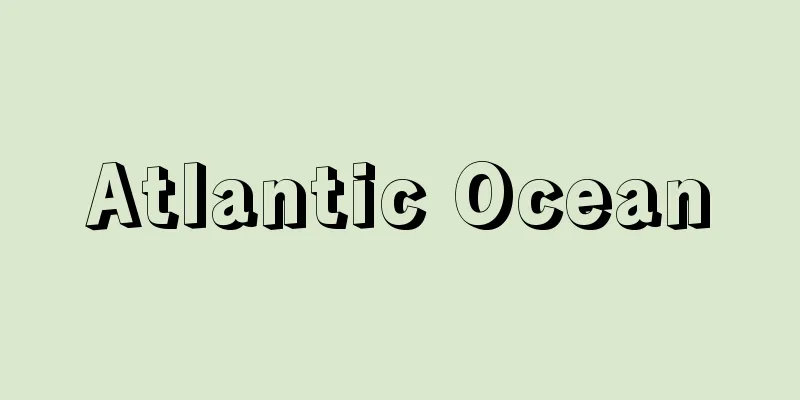Atlantic Ocean

|
It borders the European and African continents to the east and the Americas to the west, stretching from the Antarctic to the Arctic. It is one of the three great oceans along with the Pacific and Indian Oceans, and is the second largest in size after the Pacific. In ancient Greece, the southern Atlantic Ocean was called Atlanticos, as it was believed to be ruled by the giant god Atlas, who stood at the northwestern tip of the African continent. The Japanese word "Atlantic" is the Japanese translation of Oceanus occidentalis, the ancient Roman name for the entire Atlantic Ocean. [Masao Hanzawa and Kenzo Takano] AreaThe Pacific Ocean is separated by a line that runs from Cape Horn in South America to the South Shetland Islands and the Antarctic Peninsula, while the Indian Ocean is separated by a line that runs from Cape Agulhas in South Africa south along the 20th longitude to Antarctica. It has an area of 82,441,000 square kilometers, a volume of 323,610,000 cubic kilometers, and an average depth of 3,926 meters. Its affiliated seas include the American Mediterranean, the European Mediterranean, and the Arctic Ocean, and its marginal seas include the North Sea and the Gulf of St. Lawrence. Parts of the Atlantic Ocean are sometimes called the Bahama Sea and the Sargasso Sea, but the boundaries between these oceans are unclear. [Masao Hanzawa and Kenzo Takano] NatureSubmarine topographyThe most distinctive feature of undersea topography is the existence of the long Mid-Atlantic Ridge, which runs north and south in an S-shape through almost the center of the Atlantic Ocean. Most of this undersea mountain range, which stretches from the Arctic Ocean to 55 degrees south latitude, is shallower than 3,000 meters in depth, and is bisected in two by the Romanche Fracture Zone, 7,728 meters deep near the equator, forming a saddle about 4,500 meters deep. Iceland, Ascension Island, Tristan da Cunha Island, Bouvet Island, and other islands are located on this mid-ocean ridge. There are many fracture zones that run almost parallel to the Mid-Atlantic Ridge from east to west. Many of them are named after the research vessels that discovered them, such as Atlantis and Oceanographer. There are large isolated seamounts in the basin, such as the Great Meteor and Altea. Notable trenches include the Puerto Rico Trench (8,605 meters) in the North Atlantic and the South Sandwich Trench (8,325 meters) in the South Atlantic. The Mid-Atlantic Ridge is also a major boundary in terms of plate tectonics. The northern half of the eastern side of the ridge is called the Eurasian Plate, the southern half is called the African Plate, the northern part of the western side is called the American Plate, and the southern part is called the Antarctic Plate. According to the ocean floor spreading theory, the sea floor is moving eastward on the eastern side and westward on the western side. [Masao Hanzawa and Kenzo Takano] weatherThe North Atlantic is characterized by a mid-latitude high and a low pressure area to the north, while the South Atlantic is characterized by a mid-latitude high and a low pressure area surrounding Antarctica, a westerly wind belt to the south, and trade winds in the low latitude zone. The mid-latitude high in the North Atlantic is called the Azores high, and the low pressure area to the north is called the Icelandic low (low pressure). In the Southern Hemisphere, a high pressure area corresponding to the Azores high exists between 20 and 30 degrees south latitude. There is no equivalent to the Icelandic low in the South Atlantic, but there is a low pressure zone surrounding Antarctica. Strong westerly winds constantly blow between these high pressure areas and low pressure areas, and they are strongest at 35 to 45 degrees south latitude, known as the "roaring forties." Between the low-latitude northeasterly and southeasterly trade winds, there is a calm area of water called the equatorial doldrums, which is usually located between 2 and 10 degrees north latitude. Icelandic lows often develop in winter. Lows that develop in mid-latitudes move from west to east, just like in the North Pacific. In the Northern Hemisphere's summer, hurricanes, which are equivalent to Pacific typhoons, occur in the Caribbean Sea and can cause great damage in the United States and other countries. In the Grand Banks off the coast of Newfoundland in the northern North Atlantic, thick sea fog often occurs from spring to early summer as warm air is carried over the cold ocean, making the area one of the world's leading areas for sea fog. [Masao Hanzawa and Kenzo Takano] Surface currentsIn the North Atlantic, there is a counterclockwise circulation corresponding to the Icelandic low pressure area, and a large clockwise circulation corresponding to the Azores high pressure area. In the Southern Hemisphere, where the circulation direction is reversed, there is a large counterclockwise circulation corresponding to the mid-latitude high pressure area. In the high latitudes of the South Atlantic, there are no obstacles such as land or islands, so the westerly current corresponding to the westerly winds flows eastward through the South Atlantic and circles the Antarctic Ocean. (1) North Atlantic Ocean Most of the North Equatorial Current enters the American Mediterranean and becomes the Caribbean Current. It leaves the ocean and becomes the Florida Current, which merges with the Antilles Current to form the powerful Gulf Stream (Gulf Stream, Gulf of Mexico). The Gulf Stream joins the North Atlantic Current south of the Grand Banks. The Florida Current, Antilles Current, and Gulf Stream are collectively known as the Gulf Stream System. The North Atlantic Current crosses the Mid-Atlantic Ridge and flows northeast, where the water temperature is relatively high and saline, forming the maritime climate of northwestern Europe. The Irminger Current, a branch of the North Atlantic Current, merges with the East Greenland Current off the coast of Iceland and flows northward off the west coast of Greenland as the West Greenland Current. One branch of the North Atlantic Current crosses the Iceland-Faero Ridge and flows northeastward off the coast of Norway as the Norwegian Current. It enters the Barents Sea and becomes the North Cape Current, and part of it enters the Arctic Ocean and becomes the West Spitsbergen Current. This relatively warm and saline current becomes an undercurrent under the low salinity surface waters and reaches the vicinity of the New Siberian Islands. Another branch of the North Atlantic Current turns south and flows off the west coasts of Europe and Africa as the Portuguese Current and the Canary Current, and finally flows westward as the North Equatorial Current, forming a general clockwise circulation in the North Atlantic. In the northeastern coast of Canada in the North Atlantic, the cold Labrador Current flows south from the high latitudes and collides with the warm waters of the Gulf Stream off the Grand Banks, which tends to generate sea fog. This area is rich in fish and the icebergs carried by the Labrador Current can also be an obstacle to navigation. (2) South Atlantic: A current that is symmetrical to the North Atlantic current system across the equator. The less powerful Brazil Current corresponds to the Gulf Stream, the Benguela Current corresponds to the Canary Current, and the Falkland Current corresponds to the Labrador Current. Westerly currents are often called the Circumpolar Antarctic Current. There is a prominent Antarctic Convergence Zone near 50 degrees south latitude. The equatorial countercurrent that flows eastward between the South and North equatorial currents is particularly clear off the coast of the Gold Coast of Africa and is called the Guinea Current. [Masao Hanzawa and Kenzo Takano] Sea conditions, seawater, tidesThe surface salinity is the highest of the three oceans, and there are large areas in the central parts of both the North and South Atlantic where the salinity is over 37 psu. The salinity of the European Mediterranean Sea is also generally over 37 psu. In terms of the chemical composition of seawater, the deep water is characterized by a high amount of dissolved oxygen; off the coast of Greenland, the water contains 6 milliliters of dissolved oxygen per liter from the surface to 3,000 meters, indicating that the deep water of the Atlantic is young (it has been only a short time since this seawater began to sink below the surface; most of the seawater is only a few hundred years old). Most icebergs in the North Atlantic are carried by the Labrador Current and usually reach as far south as the Grand Banks, but there have been records of them drifting as far as southeast Bermuda. They often appear around the Grand Banks between March and July. Their southernmost limit is often around 42 degrees north, but they are sometimes seen as far south as 38 degrees north. Icebergs in the South Atlantic are formed when ice shelves in Antarctica break off and drift out to sea. They are called tabular icebergs and are characterized by their huge table-like shape. The tidal range along the Atlantic coast is about one meter. The spring tidal range of the Bay of Fundy at the head of the Gulf of Maine in Canada is 12.9 meters, the largest in the world. Other notable large tidal ranges include Bay of Grande in Patagonia, Argentina (latitude 51 degrees south), with a tidal range of 9.74 meters, and Saint-Malo in northwestern France, with a tidal range of 10.58 meters. [Masao Hanzawa and Kenzo Takano] Marine ResourcesUtilization of biological resources, that is, fishing, has been practiced since ancient times. The main fishing grounds are the North Sea in the northeast, around Iceland, and the waters off the Scandinavian Peninsula, and the waters off Newfoundland and Nova Scotia in the west, and the main fish species are cod and herring. These two fishing grounds, along with the waters off the coast of Sanriku in Japan, are one of the three largest fishing grounds in the world. However, due to overfishing and other factors, the catch of cod and herring in the North Atlantic has gradually decreased since the 1970s, and instead, the catch of industrial fish species such as halibut, cod, and sand lance has increased. Utilization of fishery resources in the Central and South Atlantic is not as active as in the North Atlantic, but fishing for cod such as menhaden and hake is beginning to take place. Oil and natural gas resources are actively extracted and mined in the Gulf of Mexico, Lake Maracaibo in Venezuela, the North Sea, and elsewhere. Development is also being attempted or planned off the Atlantic coast of North America (off the coasts of Newfoundland and Nova Scotia) and off the coast of the Canadian Arctic. Like the Pacific Ocean, mineral resources on the ocean floor on both sides of the equator include manganese (nodules), cobalt, nickel, and copper, but these have not yet been put into commercial use. The most notable utilization of marine energy resources is the world's first tidal power plant, located at the mouth of the Rance in France, which supplies 5.44 billion watt-hours of electricity per year. [Masao Hanzawa and Kenzo Takano] The Atlantic Ocean in World History
Almost all great voyages from ancient times to the end of the Age of Discovery were aimed at opening up new trade routes. Some representative voyages are listed below. (1) The northern voyage of exploration by Putheas (a Greek geographer from the 4th century BC) was planned and carried out at the request of merchants in Marseilles in order to disrupt the Phoenician trade monopoly. (2) The voyages to the Indian Ocean by Bartholomeu Diaz (c. 1450-1500) and Vasco da Gama (c. 1469-1524) were aimed at opening new sea routes to the East (India and China). Since the Arabs controlled the land routes from Europe to the East and the sea routes via the Persian Gulf and the Arabian Gulf, Portugal opened a new sea route that bypassed the African continent. This destroyed the Arab monopoly and was one of the factors that led to the decline of Arab power. (3) Christopher Columbus (1451-1506) voyage across the southern North Atlantic was intended to discover a new sea route that was not under Arab control, a route westward to China and India. (4) The Caboto father and son (father Giovanni Caboto, 1450-98 and son Sebastiano Caboto, 1476-1557, pronounced Cabot in English) also aimed to sail west across the northern North Atlantic to reach China and India. (3) and (4) were prevented from achieving their original objectives by the existence of the Americas. (2)-(4) and the many other voyages that followed were of great significance in world history, having brought about wars, colonization, immigration, trade, and exchanges of civilizations and cultures between the European and Asian continents, and between Europe, Africa, and the Americas. In addition to these voyages, Furthermore, although the Age of Exploration is over, These voyages brought about significant advances in the science and technology related to ships and navigation, and not only enriched our knowledge of the oceans and the marine atmosphere, but also broadened people's perspective on the size and breadth of the ocean and the various phenomena that occur there. After World War II, the emergence of missile submarines made the Atlantic a sea of tension during the Cold War. The 1949 North Atlantic Treaty strengthened military ties between the United States, Canada, and European countries, but in the 1980s conflict arose between the United States, which sought to maintain its leadership in the treaty organizations, and European countries, which sought to Europeanize the organizations. [Masao Hanzawa and Kenzo Takano] "History of World Exploration" by Kazutoshi Nagasawa (1969, Hakusuisha)" ▽ "Shogakukan Encyclopedia Volume 2: Large Ocean Map" (1980, Shogakukan) ▽ "Atlas of the World Oceans" edited by Noriyuki Nasu (1983, Kodansha)" ▽ "Global Geography of the World - The Atlantic and Pacific Oceans" by Yasuo Masai (1991, Ninomiya Shoten) [References] | | | | | | | | | | |©Shogakukan "> Atlantic Ocean bathymetry map Source: Shogakukan Encyclopedia Nipponica About Encyclopedia Nipponica Information | Legend |
|
東はヨーロッパ大陸とアフリカ大陸、西は南北アメリカ大陸に接し、南極から北極に至る海洋。太平洋、インド洋とともに三大洋とよばれ、広さは太平洋に次ぐ。古代ギリシアでは、大西洋南部をアフリカ大陸の北西端に立つ巨神アトラスが支配すると考えてアトランティコスAtlanticosとよんだ。日本語の「大西洋」は、古代ローマでの大西洋全体の呼び名Oceanus occidentalis「西の大洋」の日本語訳である。 [半澤正男・高野健三] 区域南アメリカのホーン岬からサウス・シェトランド諸島、さらに南極半島に至る線で太平洋と、南アフリカのアガラス岬(アグリアス岬)から東経20度沿いに南下して南極大陸に至る線でインド洋とくぎられる。面積8244万1000平方キロメートル、体積3億2361万立方キロメートル、平均深度3926メートルである。付属海にアメリカ地中海、ヨーロッパ地中海、北極海、縁海に北海、セント・ローレンス湾などがある。大西洋の一部をバハマ海、サルガッソー海などとよぶことがあるが、これらの海の境界ははっきりしていない。 [半澤正男・高野健三] 自然海底地形海底大地形でもっとも特徴があるのは、大西洋のほぼ中央部を南北にS字状に連なる長大な大西洋中央海嶺(かいれい)の存在である。北極海から南緯55度に至るこの海底の大山脈は、大部分の深度が3000メートルより浅く、赤道付近で深さ7728メートルのロマンシュ断裂帯によって両断され、深さ4500メートル内外の鞍部(あんぶ)が形成されている。この中央海嶺上には、アイスランド、アセンション島、トリスタン・ダ・クーニャ島、ブーベ島などがある。 大西洋中央海嶺を横断してほぼ平行に東西に走る多くの断裂帯がある。アトランティス、オーシャノグラファーなど、発見した観測船の名をつけられたものが多い。海盆中には巨大な孤立した海山があり、グレート・メテオール、アルテアなどが有名である。海溝は北大西洋のプエルト・リコ海溝(8605メートル)、南大西洋のサウス・サンドイッチ海溝(8325メートル)などが顕著である。 大西洋中央海嶺はまた、プレートテクトニクスの面からも主要な境界となっている。海嶺東側の北半分はユーラシアプレート、南半分はアフリカプレート、西側の北はアメリカプレート、南は南極プレートとよばれ、海洋底拡大説によれば東側は東方へ、西側は西方へと海底が移動している。 [半澤正男・高野健三] 気象北大西洋では中緯度高気圧とその北方の低圧部が、南大西洋では中緯度高気圧と南極大陸を取り巻く低圧部が、さらにその南の偏西風帯と、低緯度地帯の貿易風が特徴である。北大西洋の中緯度高気圧をアゾレス高気圧、その北の低圧部をアイスランド低圧部(低気圧)という。南半球では南緯20~30度にアゾレス高気圧に対応する高圧部が存在する。アイスランド低圧部に相当するものは南大西洋にはなく、南極大陸を囲む低圧帯が存在する。この高圧部と低圧帯との間には恒常的に強い偏西風が吹き、「ほえる40度roaring forties」とよばれる南緯35~45度においてもっとも強い。低緯度の北東・南東両貿易風の間には赤道無風帯とよばれる静かな海域があり、通常北緯2~10度に位置する。 アイスランド低気圧は冬季によく発達する。中緯度に発生・発達した低気圧は、北太平洋と同じく西から東へ進む。北半球の夏季、カリブ海には太平洋の台風に相当するハリケーンが発生し、アメリカなどに大きな被害をもたらすことがある。北大西洋北部、ニューファンドランド沖のグランド・バンクスでは、春から初夏にかけて温かい空気が冷たい海上に運ばれるため、濃い海霧がしばしば発生し、世界有数の海霧卓越海域となっている。 [半澤正男・高野健三] 表面海流北大西洋ではアイスランド低圧部に対応する反時計回りの循環、アゾレス高気圧に対応する大きな時計回りの循環がある。循環の向きが逆になる南半球では、中緯度高気圧に対応して大きな反時計回りの循環がある。南大西洋の高緯度地方では、陸地や島などの障害がないので、偏西風に対応する西風海流が、南大西洋を東に流れ、南極海を一周している。 (1)北大西洋 北赤道海流の大部分はアメリカ地中海に入りカリブ海流となる。その海を出てフロリダ海流となり、アンティル海流と合流して、強大なガルフストリーム(湾流、メキシコ湾流)を形成する。ガルフストリームはグランド・バンクスの南で北大西洋海流につらなる。フロリダ海流、アンティル海流、ガルフストリームをガルフストリーム・システム(湾流系)と総称する。北大西洋海流は大西洋中央海嶺を越えて北東に進むが、水温が比較的高く高塩分であり、北西ヨーロッパの海洋性気候を形成する。 北大西洋海流の分枝の一つイルミンガー海流はアイスランド沖で東グリーンランド海流とあわさって、グリーンランドの西海岸沖を西グリーンランド海流となって北上する。北大西洋海流の一つの分枝はアイスランド―フェロー海嶺を越え、ノルウェー沖をノルウェー海流となって北東に流れる。これはバレンツ海に入ってノース・ケープ海流となり、さらに一部は北極海に入って西スピッツベルゲン海流となる。比較的温かく塩分の高いこの海流は、低塩分の表面水の下を潜流となってノボシビルスク諸島付近にまで達する。北大西洋海流のもう一つの分枝は向きを南に変えて、ヨーロッパ大陸、アフリカ大陸の西岸沖をポルトガル海流、カナリー海流となって流れ、最終的には北赤道海流となって西へ向かい北大西洋の時計回りの大循環を形成する。 北大西洋北部のカナダ北東沖には高緯度地方から寒冷なラブラドル海流が南下してグランド・バンクス沖でガルフストリーム系の暖水とぶつかり、海霧を発生させやすい。この海域は魚類の豊富な漁場となっている。またラブラドル海流が運んでくる氷山が、航海の障害になることもある。 (2)南大西洋 赤道を狭んで北大西洋の海流系と対称となる形の流れである。ガルフストリームに対応してそれほど強大ではないがブラジル海流があり、カナリー海流にはベンゲラ海流、ラブラドル海流にはフォークランド海流がそれぞれ対応する。西風海流は周南極海流といわれることが多い。南緯50度付近には顕著な南極収束帯がある。南・北赤道海流の間を東へ向かって流れる赤道反流は、アフリカの黄金海岸沖合いでとくに明瞭(めいりょう)になり、ギニア海流とよばれる。 [半澤正男・高野健三] 海況・海水・潮汐表面の塩分は三大洋のなかでもっとも高く、南北両大西洋それぞれの中央部には、塩分が37psu以上の海域が広がっている。ヨーロッパ地中海の塩分もおおむね37psu以上である。海水の化学成分では深層水の溶存酸素量が高いのが特徴で、グリーンランド沖では表面から3000メートルまで、1リットル中6ミリリットルを含み、大西洋深層水の年齢が若い(この海水が海面から沈降し始めたときからの経過年月が短い。数百年程度の海水が多い)ことを示している。 北大西洋の氷山は大部分がラブラドル海流で運ばれて、通常グランド・バンクスの南まで達するが、バーミューダ南東まで流れていった記録もある。グランド・バンクス付近では3月から7月までの間によく現れる。北緯42度付近が頻繁にみられる南限、ときどきみられる南限は北緯38度ぐらいである。南大西洋の氷山は南極大陸の棚氷(たなごおり)が崩れて海上に流出したもので、卓状氷山といい、巨大なテーブル状になっているのが特徴である。 大西洋沿岸の潮差は約1メートルである。カナダ、メーン湾奥のファンディ湾の大潮(おおしお)潮差は12.9メートルで世界最大である。アルゼンチン、パタゴニア(南緯51度)のグランデ湾の9.74メートル、フランス北西部サン・マロの10.58メートルなどが大きな潮差の代表である。 [半澤正男・高野健三] 海洋資源生物資源の活用、すなわち漁業は古くから行われている。主要漁場は北東部の北海、アイスランド周辺、スカンジナビア半島近海と、西部のニューファンドランド、ノバスコシア近海で、主要魚種はいずれもタラとニシンである。両漁場は、日本の三陸沖とともに世界の三大漁場となっている。ただし乱獲などの影響で、タラ、ニシンの北大西洋における漁獲は1970年代より漸減し、かわってオヒョウ類、ソコダラ類、イカナゴなどの産業用魚種の漁獲が増えている。中部・南大西洋の水産資源の活用は、北大西洋ほど盛んではないが、メンヘデン、メルルーサなどソコダラ類の漁業がおこりつつある。 石油・天然ガス資源の採取・採掘が盛んなのはメキシコ湾、ベネズエラのマラカイボ湖、北海などである。このほか北アメリカの大西洋岸沖(ニューファンドランド、ノバスコシア沖)、カナダ領北極圏の沖などでも開発が試みられたり、計画されたりしている。海洋底の鉱物資源は太平洋と同じく赤道を挟み、マンガン(団塊)、コバルト、ニッケル、銅などがあるが、事業化には至らない。海洋エネルギー資源の活用でもっとも注目されるのは、世界最初の潮汐発電所がフランスのランス河口にあり、年間54.4億ワット時の電力を供給していることである。 [半澤正男・高野健三] 世界史における大西洋
古代から大航海時代の終りころまでの大航海は、ほぼすべて新しい交易路の開拓を目ざしていた。以下に代表的航海をあげる。 (1)ピュテアスPutheas(紀元前4世紀のギリシアの地理学者)の北方探検航海は、フェニキア人の独占貿易を阻むためマルセイユの商人たちの依頼で企画され、実行された。 (2)ディアスBartholomeu Diaz(1450ころ―1500)、ガマVasco da Gama(1469ころ―1524)のインド洋への航海は東方(インド、中国)への新航路の開拓が目的だった。アラビア人がヨーロッパから東方への陸路とペルシア湾、アラビア湾経由の海路を支配していたので、ポルトガルはアフリカ大陸を迂回(うかい)する新しい航路を開拓した。アラビア人の独占は崩れ、アラビア人勢力衰退の一因になった。 (3)コロンブスChristopher Columbus(1451―1506)の北大西洋南部の横断航海は、アラビア人の支配下にない新しい航路、西へ進んで中国・インドに到る航路の発見が目的だった。 (4)カボート父子(父はGiovanni Caboto,1450―98、子はSebastiano Caboto,1476―1557、英語読みはキャボットCabot)の北大西洋北部の横断航海も西へ進んで中国・インドに到ることが目的だった。 (3)と(4)はアメリカ大陸の存在にはばまれて、当初の目的を達成できなかった。(2)~(4)の航海とあとに続く多くの航海は、ヨーロッパ・アジア大陸間、およびヨーロッパ・アフリカ・アメリカ大陸間の戦争、植民、移民、交易、文明・文化の交流をもたらしたことによって、世界史に大きな意味をもつ。 これらの航海に加えて、 さらに、大航海時代は終っているが、 これらの航海によって、船と航海にかかわる科学・技術は著しく進歩し、海と海上大気についての知識が豊かになっただけではなく、海の大きさ、広さ、そこに繰り広げられるいろいろな現象が人々の視野を広げることになった。 第二次世界大戦後は、ミサイル潜水艦の出現によって冷戦時代には大西洋は緊張の海となった。1949年の北大西洋条約はアメリカ・カナダとヨーロッパ諸国の軍事上の結束を強めたが、1980年代になって条約機構の主導権を維持しようとするアメリカと条約機構のヨーロッパ化を目ざすヨーロッパ諸国の対立が生まれた。 [半澤正男・高野健三] 『長沢和俊著『世界探検史』(1969・白水社)』▽『『小学館百科別巻2 海洋大地図』(1980・小学館)』▽『奈須紀幸監修『世界海洋アトラス』(1983・講談社)』▽『正井泰夫著『グローバル世界地誌――大西洋圏と太平洋圏』(1991・二宮書店)』 [参照項目] | | | | | | | | | | |©Shogakukan"> 大西洋の海底地形図 出典 小学館 日本大百科全書(ニッポニカ)日本大百科全書(ニッポニカ)について 情報 | 凡例 |
>>: Restoration of Imperial Rule - Taiseihokan
Recommend
Kantaka Chetiya Tower
...The Thupārama Stupa is a historic tower dating...
Battleship Potyomkin (English: Battleship Potyomkin)
Soviet film. 1925 production. Directed by Sergei ...
Kisenzan
...For example, the autumn moon is like meeting t...
Small Theatre
A small theater. ※The Capital of a Nation (1899) b...
《Ecri》 - Ekuri
...This caused a great intellectual reaction, and...
Megachilidae
...General term for insects of the superfamily An...
ad hoc
...Also, when a certain hypothesis encounters an ...
Yellow-legged Termite - Yellow-legged Termite
...The Takasago termite builds a spherical nest o...
Dollar diplomacy - dorugaikou (English spelling) dollar diplomacy
Originally, it was a term that characterized the ...
Cao Yu
Chinese playwright. Born in Tianjin, Qianjiang Co...
Icebreaker - Saihyousen (English spelling) ice breaker
A ship that breaks ice that has built up on the s...
Matoa
...Lychee and longan in southern China, rambutan ...
Pyrola
…An evergreen perennial plant of the family Pruna...
Marl (English spelling)
Marl, as it is commonly used today to describe sed...
Karl Ernst von Baer
Born: February 29, 1792. Peep [Died] November 28, ...









